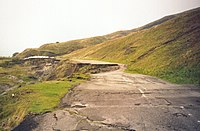Believe me, I swear: I really, truly, honestly am trying to see things from your perspective. ![]()
However, to date, I do not “get it”. I don’t see what you see. Where you keep losing me is that we don’t have a common understanding of “abandoned”. You keep reinforcing the point that abandoned:railway=yes / railway=abandoned means “partially dismantled”, but you’re giving me examples of ENTIRELY dismantled things. Your understanding, to me, flies in the face of the definition at Key:abandoned - OpenStreetMap Wiki :
I don’t bristle at the idea of mapping railway infrastructure that has been abandoned, in the sense that it has been deserted and no longer maintained but is still easily recognizable for its original purpose. To me if something is only partially dismantled then by corollary it should be at least partially usable for its original purpose: in this case, having a train / tram / whatever roll along a set of tracks.
To me, that little bridge you shared a photo of isn’t a piece of railway in a “phase of its lifecycle”: there is no railway. It’s not railway=abandoned, it’s “railway=nonexistent”. It has ceased to be railway. It’s gone! And at that point, in my opinion frankly it shouldn’t be on OSM as a railway. It looks to me like it’s now just a highway=footway. You can’t “put it back into operation with expensive repairs”: you would have to build an entirely new railway.
You gave an example of a building in ruins as an analogy, but I think your analogy is fundamentally flawed, and runs entirely counter to your principal argument. A pile of rubble is categorically not a building. “Bricks in a roughly rectangular shape” outlining where a building once stood is not a building. Some fragments of a stone wall that was once a building is still not a building; all of this I think we can agree on. But where we seem to disagree is that you perceive ruins:building=yes to mean “a building that is in ruins”, that “ruins” is just a state of its lifecycle. Whereas to me it is “ruins, which happened to have been a building, at some point”. It is no longer a building, and has since become ‘ruins’. ruins:* is not a “lifecycle prefix”, it is a thing unto itself. A building will go from being occupied to being unoccupied, disused, abandoned, and eventually it will fall apart or be torn down such that it is not a building anymore, and if there’s something left it may be ruins:building. If there’s nothing left then I tend to mark the area as landuse=brownfield (particularly urban sites that will be redeveloped soon), or… just delete it. Likewise, a railway goes from being in use, to being disused, to being abandoned, and eventually it falls apart or is dismantled to the point it is no longer a railway at all. If the path the railway followed has pedestrians walking along it it has become a highway=footway. If it has been paved over and is used by motor vehicle traffic it has become a road (with whatever level of highway=* tagging). If the path the railway followed is left fallow it’s… nothing. It has ceased to be a mappable feature and ought to be deleted.
To me, what you’re arguing is that an “abandoned railway” consists of “the course of a former railway where the tracks are gone, but some teeny, tiny shred of evidence that it ever existed it still discernable by a railway aficionado”. That does not jive with common sense to me. Common sense tells me that a railway ceases to be abandoned:railway when it is no longer usable as a railway whatsoever, in exactly the same way a building ceases to be abandoned:building when it cannot be used as a building whatsoever anymore. If the walls and the roof are gone, it ain’t a building anymore. Likewise, when the rails are gone it ain’t a railway anymore. Sure, there may be the remnants of a right-of-way left over, and those remnants may be there for a long time, but evidence of something having been there long, long ago does not constitute still being that “something”, merely in some state of disrepair due to abandonment.
Fortunately it seems there’s very little in the way of railway=dismantled and railway=razed on the map in my little corner of the world. However, enterprising individuals have put some railway=abandoned on the map, and in these instances the very idea that it’s merely “abandoned” is risible. E.g.: Way: 335308535 | OpenStreetMap
You mean to tell me that this:
… is railway=abandoned? Even if you called this railway=dismantled or railway=razed, you might as well be telling me down is up, up is down, and the sky is green.
This way was originally tagged highway=path, about five months later someone added railway=abandoned, and three years after that someone else deleted highway=path from it and declared in their changeset comment that they did so because it was a “misused tag on an abandoned railway”. It’s been on the map as railway=abandoned ever since (almost six years).
I went and googled this former stretch of railway; do you know how long ago it was abandoned?
1976.
![]()
It’s GONE. It’s been gone for half a century. Like… what the @#$% are we talking about here, guys? It’s a farmer’s field!









